In 1976, the U.S. was preparing to celebrate the Bicentennial—the 200th anniversary of the Declaration of Independence. As part of the festivities, the U.S. Mint decided to create a commemorative Kennedy half dollar. This coin was stamped with the dual dates of 1776 and 1976.
Almost 533 million of these coins were produced between 1975 and 1976. So, don’t be surprised if you see some in your pocket change today.
But how much is this special Kennedy half dollar worth? What errors make it even more valuable? Stay tuned to learn more about this magnificent commemorative coin.
1776 to 1976 Half Dollar Value Details
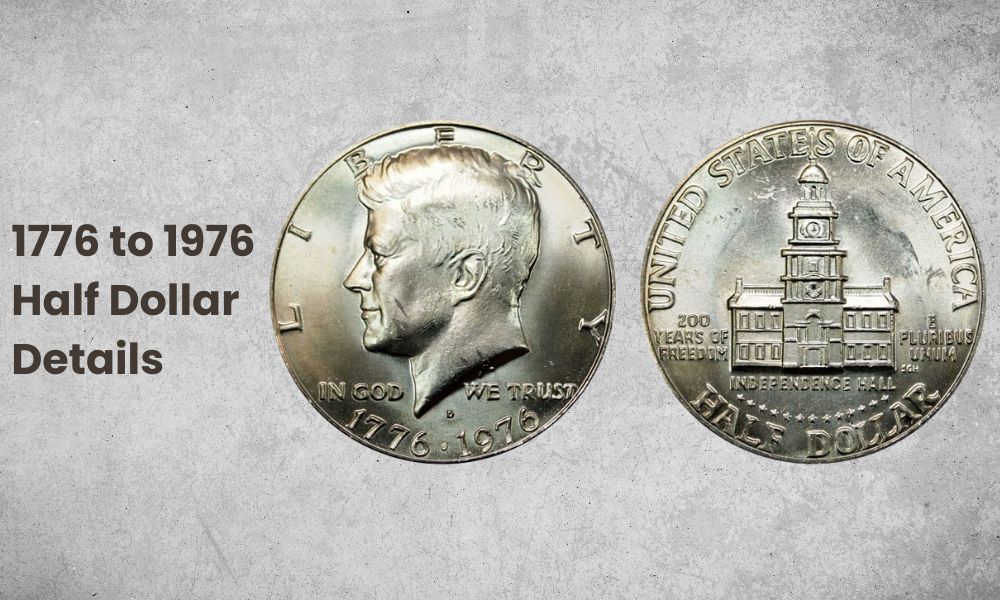
- Category: Kennedy Half Dollars
- Mints: Philadelphia, Denver, and San Francisco
- Total mintage: 532,873,248
- Obverse designer: Gilroy Roberts
- Reverse designer: Seth G. Huntington
- Edge: Reeded
- Diameter: 30.6 mm
- Content: Copper-nickel clad copper (Philadelphia and Denver), Silver (San Francisco)
- Weight: 11.34 grams (Philadelphia and Denver), 11.5 grams (San Francisco)
The U.S. government had a lot planned for the 1976 Bicentennial of the Declaration of Independence. There were events planned for it left and right, including a Wagon Train Pilgrimage to re-enact the journey of Americans to Pennsylvania 200 years prior.
One remarkable thing the U.S. Treasury did for the Bicentennial was to produce special coins to commemorate the occasion. Commemorative coins are legal tender, so they would be distributed for public circulation.
One commemorative coin for the Bicentennial was the 1776 to 1976 half dollar. On its obverse, you’ll see Gilroy Roberts’ original 1964 Kennedy half dollar design with former president John F. Kennedy’s side profile.
Around the obverse rim are the letters that spell “LIBERTY.” Below Kennedy’s head are the phrases “IN GOD” and “WE TRUST,” split by his truncated neck. And on the bottom of the coin are the dual dates “1776-1976.”
The reverse is a special design that depicts the Independence Hall. It was created by Seth G. Huntington. This replaced Frank Gasparro’s design of the Presidential Seal solely for the Bicentennial commemorative half dollar issue.
To the left of the hall are the words “200 Years of Freedom,” and to its right, the American creed “E pluribus unum.” Around the reverse rim, “United States of America” and “Half Dollar” are written.
Also Read: Top 15 Most Valuable Kennedy Half Dollar Worth Money
1776 to 1976 Half Dollar Value Chart
| 1776 to 1976 Half Dollar Value Chart | ||||||
| Mint Mark | Extremely Fine | AU58 About Uncirculated | MS62 Uncirculated | MS66 Gem Uncirculated | MS67 Superb Gem Uncirculated | |
| 1776 to 1976 Half Dollar Value for No Mint Mark (P) | $0.75 | $0.75 | $2 | $135 | $1,850 | |
| 1776 to 1976 Half Dollar Value for “D” Mint Mark | $0.75 | $0.75 | $2.25 | $45 | $975 | |
| 1776 to 1976 Half Dollar Value for “S” Mint Mark (Silver) | $3.45 | $3.65 | $6 | $30 | $47 | |
1776 to 1976 Half Dollar Values and Varieties Guides
1776 to 1976 Half Dollar Value for No Mint Mark (P)
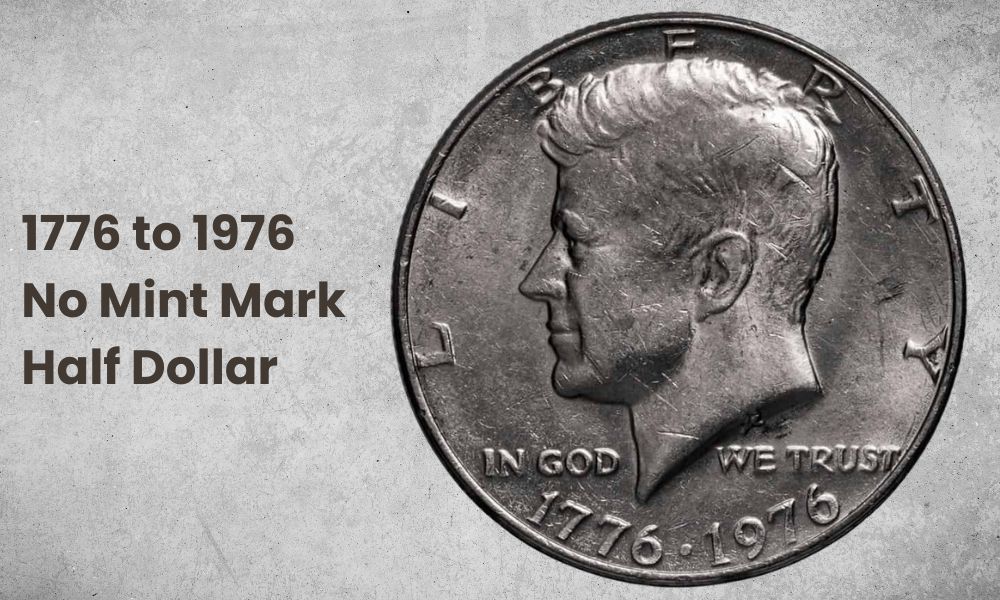
- Type: Kennedy Half Dollars
- Edge: Reeded
- Mint mark: No mint mark (P)
- Place of minting: Philadelphia
- Year of minting: 1975 and 1976
- Face value: $0.50
- $ price: $0.75 to $1,850
- Quantity produced: 234,308,000
- Obverse designer: Gilroy Roberts
- Reverse designer: Seth G. Huntington
- Content: 75% copper and 25% nickel clad over pure copper
The Philadelphia Mint did its part in minting the bicentennial half dollars by producing 234 million of the coins from 1975-1976.
In circulated condition, the price of 1776 to 1976 (P) half dollar is stable at $0.75. This price goes all the way up to AU58. This coin’s value only reaches the one-dollar mark at the uncirculated grade of MS61, when the price hits $1.25.
The Philly-minted bicentennial half dollars are commonly found in mid-to-high uncirculated conditions, specifically grades MS64 through MS66. An MS64 coin could get you around $15 when sold. On the higher end of the spectrum, an MS66 is valued today at $135.
And if you’re lucky enough to have an MS67 bicentennial Kennedy half dollar in your collection, you might be surprised to learn that it’s valued at almost $1,900 today.
1776 to 1976 Half Dollar Value for “D” Mint Mark
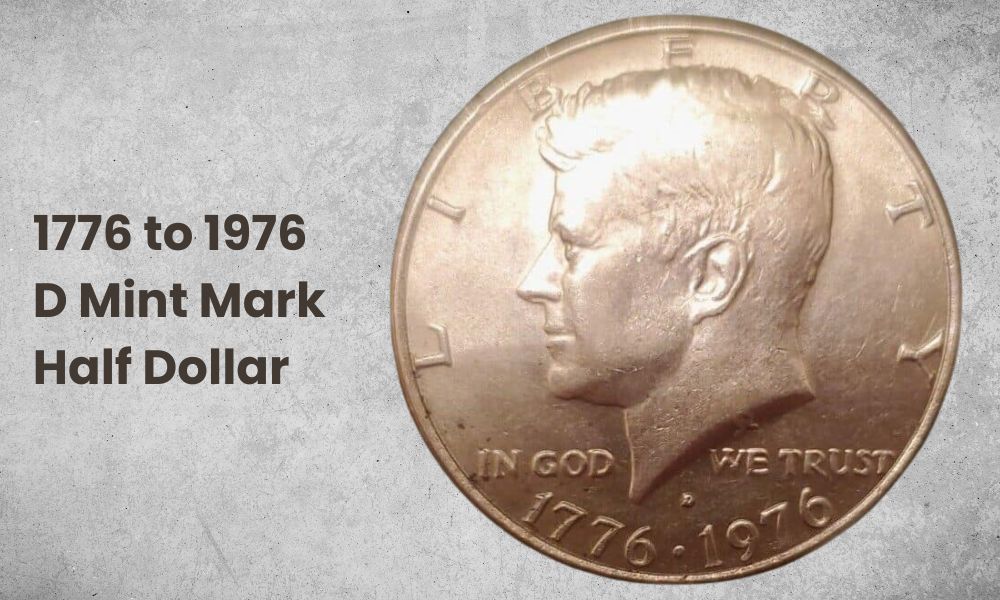
- Type: Kennedy Half Dollars
- Edge: Reeded
- Mint mark: D
- Place of minting: Denver
- Year of minting: 1975 and 1976
- Face value: $0.50
- $ price: $0.75 to $3,250
- Quantity produced: 287,565,248
- Obverse designer: Gilroy Roberts
- Reverse designer: Seth G. Huntington
- Content: 75% copper and 25% nickel clad over pure copper
The Denver Mint produced the highest number of 1776 to 1976 half dollars for the U.S. Bicentennial. The total mintage for the project in Denver alone was over 287.5 million coins.
The Denver-minted coins’ prices don’t differ much from those struck in Philadelphia. Well, at least for the circulated coins. From grades PO1 to AU58, these coins are stable at the $0.75 price point.
In uncirculated conditions, the values get higher but not as high as those of their Philadelphia-minted cousins. This is likely because the Denver-minted coins are the least scarce. For example, at MS66, the D mint-mark coin is valued at $45—a far cry from a (P) coin’s $135 in that grade.
That said, at very high grades, this coin is incredibly valuable. At the near-perfect coin grade of MS67+, you can price this coin at $3,250 if you were to sell it.
One thing that can raise the prices of these Denver-minted coins is mint errors. For example, an MS64 1776 to 1976 D half dollar is usually valued at $15. But with a struck 75% off-center error, the price shoots up to almost $500.
1776 to 1976 Half Dollar Value for “S” Mint Mark
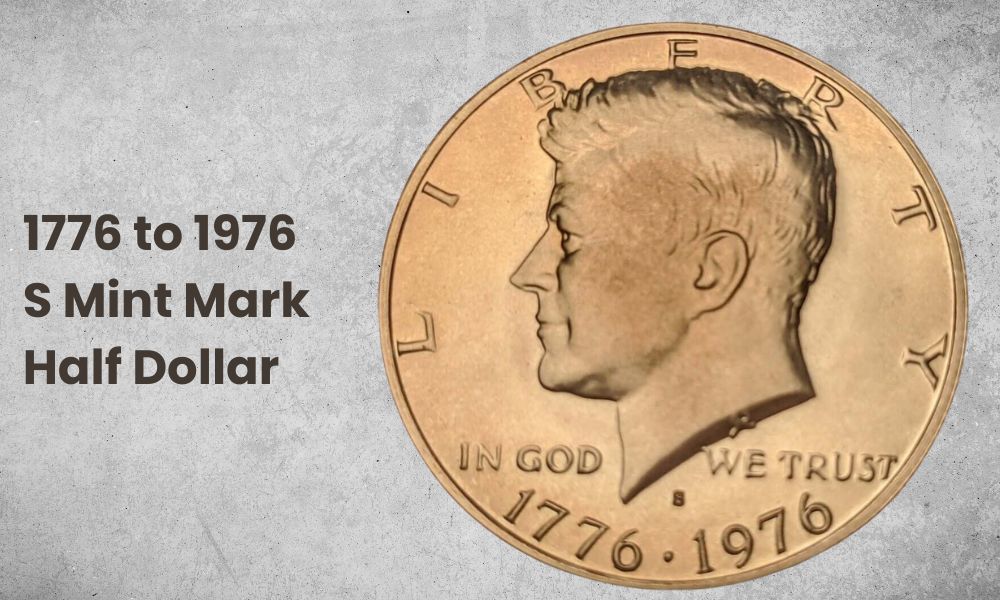
- Type: Kennedy Half Dollars
- Edge: Reeded
- Mint mark: S
- Place of minting: San Francisco
- Year of minting: 1975 and 1976
- Face value: $0.50
- $ price: $3.25 to $220
- Quantity produced: 11,000,000
- Obverse designer: Gilroy Roberts
- Reverse designer: Seth G. Huntington
- Content: 40% silver
- Melt value: $3.06 (as of March 2023)
The San Francisco Mint is the only U.S. Mint to produce silver-clad half dollars for the 1776 to 1976 issue. They were made with 40% silver. Only 11 million of them were created, so they’re quite scarce. That said, this scarcity doesn’t translate to a high value today.
Surprisingly, these coins are more valuable than the ones minted in Philadelphia and Denver, but only in the circulated grades. Because the 1776 to 1976 S half dollars are made of silver, their current value will always be tied to their melt value. Today in 2023, that means a minimum of $3.
In good condition, this San Francisco-minted coin can be sold for $3.25. The value increases a bit going up to AU58, where it hits the $3.65 price point.
The value goes up in uncirculated conditions, but not in the same trajectory as the bicentennial half dollars made in Philadelphia and Denver. An MS66 coin, for example, will only be valued at $30.
Even at a high grade of MS67, this coin’s value isn’t that impressive, priced at only $47. In a pristine, lustrous MS68 grade, you can expect this coin to be worth $220.
History of the 1776 to 1976 Half Dollar
After John F. Kennedy was assassinated in 1963, putting him on a U.S. coin was immediately considered. It was decided that he would be put on the half dollar, replacing the Franklin coin.
There was some dispute about whether this was allowed. A coin cannot be changed until it reaches its 25-year mark, and the Franklin had only been around for 15 years.
But Congress felt so strongly about the Kennedy half dollar that they passed legislation to allow for the change. And in 1964, the Kennedy half dollar was born.
After the half dollar had a good run for a little over a decade, it was announced that commemorative coins would be minted for the 1976 U.S. Bicentennial. The Kennedy half dollar was one of these coins.
The U.S. Mint hosted a design competition open to any American sculptor who wanted to create a reverse design for the commemorative coins.
Among the hundreds of submissions of emblematic American designs, 12 semi-finalists were later announced. In the end, it was Seth G. Huntington’s depiction of the Independence Hall that was assigned to the Kennedy half dollar.
The 1776 to 1976 Kennedy half dollar was minted in 1975-1976 and was then put in circulation during the year of the Bicentennial. The poignant commemorative coin remains common today.
1776 to 1976 Half Dollar Grading
It can be challenging to look at the condition of a 1776 to 1976 half dollar. If you need the exact grade, you can hire an expert to do it for you. Here’s a quick guide to tell if your coin is circulated or uncirculated.
- Uncirculated: The high points of the coin—like Kennedy’s cheekbone and the tips of the Independence Hall—will show wear. There might be smooth spots where there should be intricate details and design. The coin’s luster might not be so bright.
- Circulated: In mint state, there should be no wear on the coin. Contact marks should be at a minimum. Luster should be immensely shiny and have good eye appeal.
Here’s a very helpful video on how to look for signs of circulation in your Kennedy half dollars:
1776 to 1976 Half Dollar Errors
It might be surprising for some to learn that 1776 to 1976 half dollars have plenty of mint errors. This was somewhat expected due to the sheer quantity of the coins struck. Here are a few examples of the errors you can find in these commemorative coins:
1. 1776 to 1976 Half Dollar Full Brockage Error
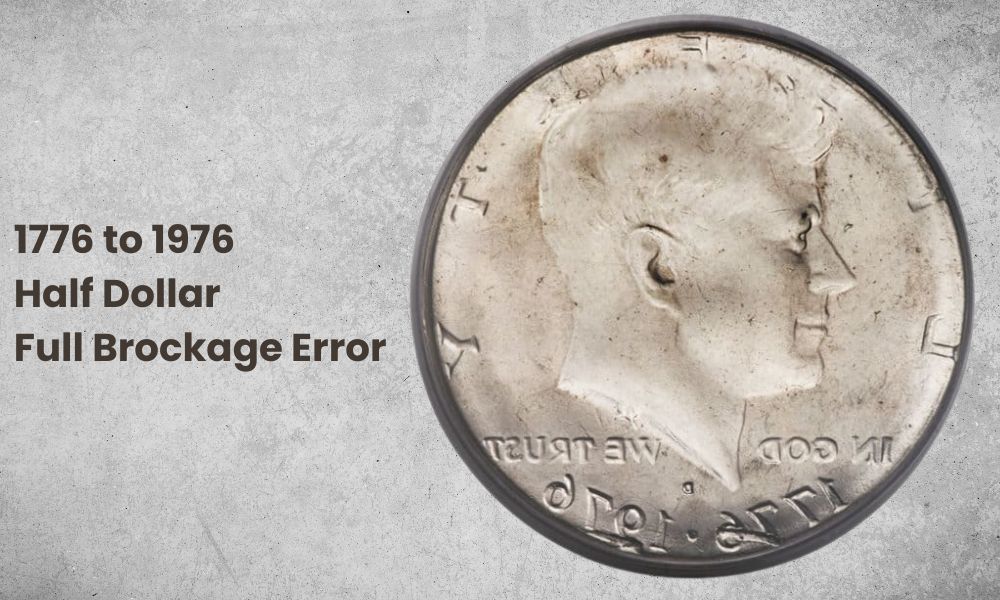
One of the more unique mint errors found on a 1776 to 1976 half dollar is a full brockage error. This happens when an already-struck coin gets stuck to the die and is imprinted on the next planchet. As a result, there’s a mirror image of the design in an inward strike.
This error was found on an MS64 Denver-minted coin, which was sold for over $4,400. On the coin’s obverse, you’ll see Kennedy facing right instead of left and inverted letters.
2. 1776 to 1976 Half Dollar Curved Clip Error
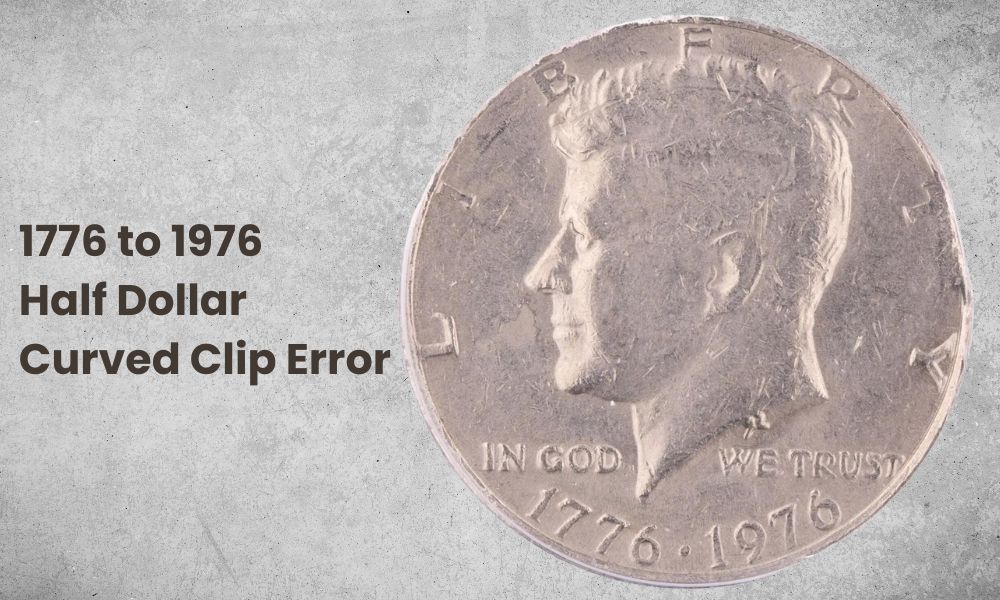
There are also a lot of curved clip errors in the 1776 to 1976 half dollar issue. A curved clip is when a punch die strikes a planchet that was already punched into shape. It gives the coin a concave clip on one or more sides.
A curved clip can raise the value of any 1776 to 1976 half dollar. An AU55 with a curved clip in its six o’clock position was sold in 2017 for $69. A coin of this grade usually only sells for $0.75.
Some 1776 to 1976 half dollars have more than one curved clip.
3. 1776 to 1976 Half Dollar Reverse Lamination Error
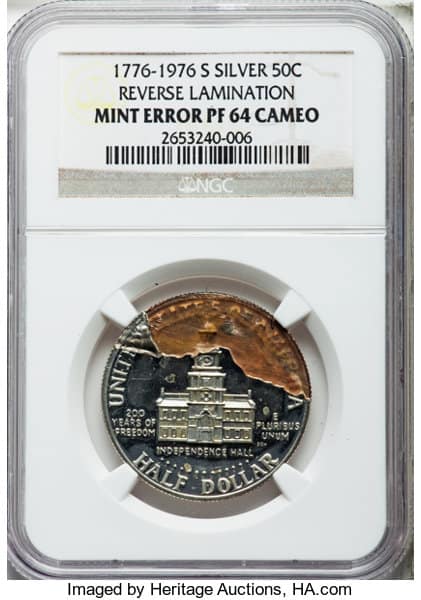
A lamination error occurs when the surface of a coin starts to flake and crack. It usually happens when the alloy is contaminated and starts to separate.
This type of error has been found in a 1776 to 1976 S silver half dollar proof. The lamination starts to crack and chip off at the top of the Independence Hall on the reverse. It was graded MS64 and was sold for over $490.
Curious to see how these errors look on the majestic bicentennial half dollar? Check them out in this video:
1776-1976 Half Dollar FAQs
How can you tell if a Kennedy Half Dollar is rare?
Many things make Kennedy half dollars rare. These include odd mint errors or a very high coin grade, like MS67 or MS68. The date also makes the coin rarer. The unique dual dates of 1776-1976 are an example that raises the value of the Kennedy half dollar.
What makes a 1776-1976 half dollar rare?
The 1776-1976 half dollars were minted with the double date on the obverse to celebrate the United States Bicentennial. Because of that, there are no Kennedy half dollars with the dates 1975 or 1976. It’s rare because it’s a commemorative coin.
Are all 1976 half dollars 40% silver?
No, only the San Francisco-minted 1976 half dollars were composed of 40% silver. The ones produced in Philadelphia and Denver (which easily account for over 95% of the half dollars minted then) had no silver and were made of copper-nickel-clad copper.
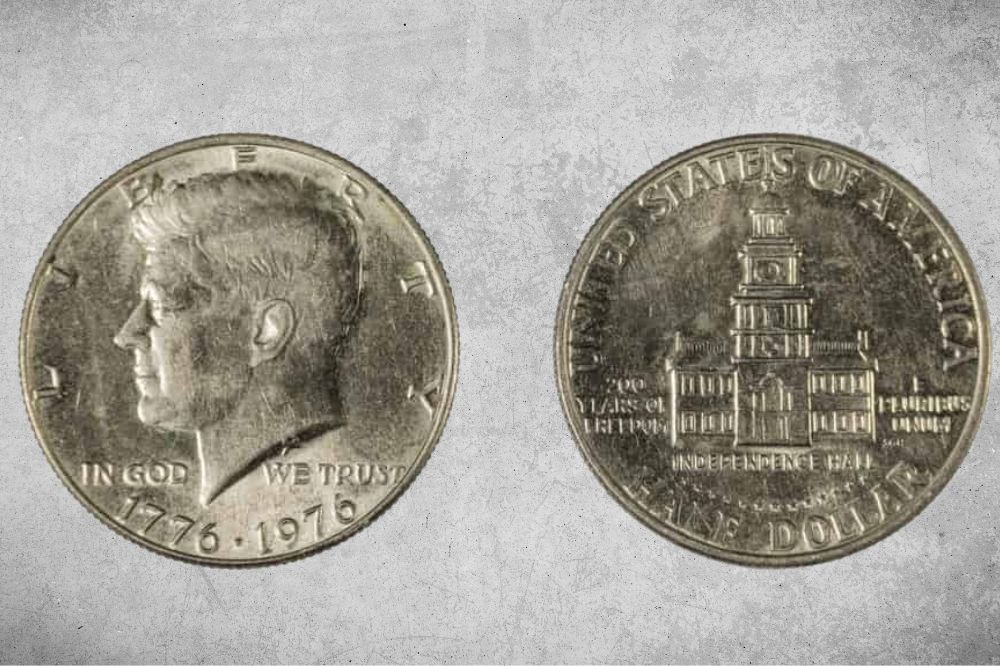
Tengo un medio dólar de 1776
1976 y dos monedas de un dólar de 1776
Tenggo 6 medios dollars 1776 1976 en perfect as condiciones